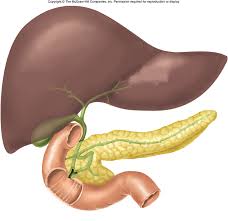Liver
The liver is a large organ on the upper right side of your torso, opposite the stomach and behind the ribcage. One of its main functions is to make a substance called bile (composed mostly of bilirubin, bile salts, and cholesterol) that is required to digest food in the small intestine.
The liver is divided into two sections: a right lobe and a left lobe. Both lobes are made up of cells called hepatocytes. These cells produce bile and secrete it into the bile ducts, which carry bile to the gallbladder where it is stored until used by the small intestine.
Gallbladder and Bile Ducts
The gallbladder is a pear-shaped sac under the right lobe of the liver. Between meals, it stores and concentrates bile, which is produced at a constant rate by the liver. When it is not full of bile, the gallbladder is about 3 inches long and 1 inch wide at its thickest part.
After meals, the gallbladder releases bile into the duodenum to aid with digestion. The cystic duct carries bile from the gallbladder to the common bile duct, which empties into the duodenum. Entry of bile into the duodenum is regulated by layers of muscle called the sphincter of Oddi.
Between meals, the sphincter of Oddi closes and prevents bile from entering the duodenum. During and after meals, this sphincter opens and allows bile to enter the duodenum.
Pancreas
The pancreas is a long, thin gland that lies horizontally behind the bottom part of your stomach. It makes digestive enzymes that flow through the pancreatic duct to the small intestine. These enzymes, along with bile from the gallbladder, break down food for use as energy by the body. The pancreas also makes insulin and glucagon, hormones that help regulate blood glucose (sugar) levels.



 Contact Us
Contact Us






 Hospitals
Hospitals
 Doctors
Doctors
 Diagnostic
Diagnostic
 Pharmacy
Pharmacy
 Health Tips
Health Tips
 Blog
Blog

























Comments